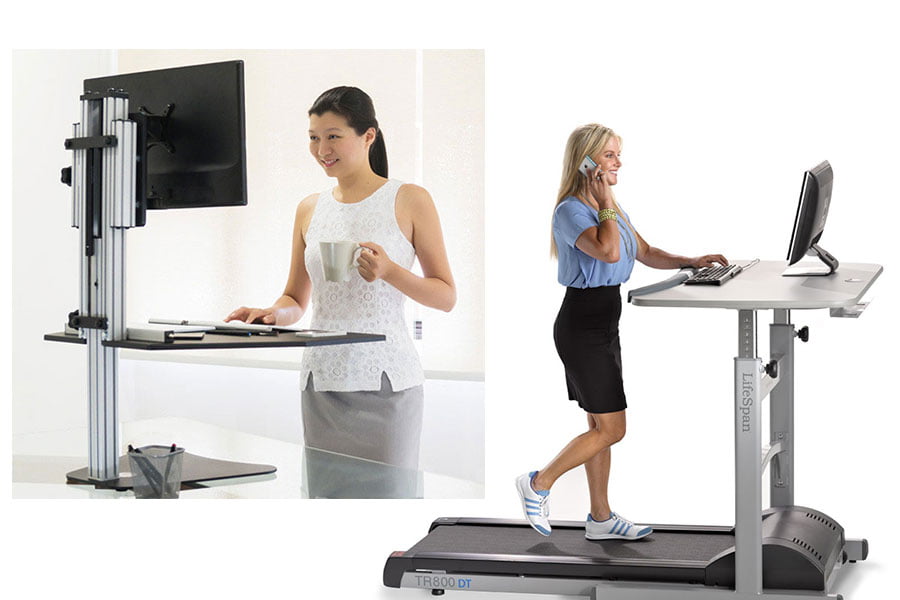
Which Is Better? Standing Desks Or Treadmill Desks
Three researchers recently crunched a bunch of data on standing desks and treadmill desks. I started using a treadmill desk in 2013 and have since moved on to a height-adjustable standing desk. Since it’s National ‘Get Fit Don’t Sit’ day (yes, that’s a thing), it’s a great time to talk about my personal experience with both walking and standing while working.
Productivity
Staying focused on the treadmill desk was a serious challenge. It proved very difficult to walk and write. I had no problem walking and checking/responding to emails or surfing the net, but when it came down to doing a job that required concentration, I found it nearly impossible and had to sit. Even at the slowest speed, walking at work wasn’t working for me.
Focus and attention on the standing desk is a cinch. There is little movement except some natural shifting that occurs. The desk I use is a Kangaroo Pro and the surface area is roomy enough for a keyboard, mouse, mouse cushion, cell phone and water glass. I use a wireless headset for my phone so I am able to type while talking.
Physical Benefits
It’s no surprise that walking while working saw optimal health benefits compared to standing and working, so the treadmill desk gets high marks in physical improvements. I also found that my chronic back pain disappeared after just a week. After six weeks of working and walking on the treadmill desk , I lost 4 pounds. My afternoon energy level increased and I found I did not need that caffeine fix any longer.
With the standing desk, I notice the same benefits such as less chronic back pain and more energy. I do not notice, however, any weight loss. I am able to stand up to 45 minutes before I start fidgeting and know it’s time to change positions. But, that’s alright, the standing desk is not designed to keep standing all day long. In fact, standing for too long can cause other physical ailments so it’s important to give your body balance with both sitting and standing.
Recommendations
Both standing desks and treadmill desks create a healthier work space. Here are some user tips to help manage your transition.
Treadmill Desk Tips:
1. Be sure to take it slowly. A treadmill desk speed begins at .04 mph. Don’t jump on and think you’re going to be keeping up speeds similar to the gym.
2. You may feel dizzy the first couple of times. Be sure to take frequent breaks and the dizziness should subside completely after your first week to 10-days.
3. Be sure you have an ergonomic setup on your treadmill desk. If you find yourself bending down to view a monitor, STOP and get yourself a monitor stand to raise it up. No matter where you are working, your monitor’s top line of text should be even with your eyes, then let your gaze fall to the middle of your screen.
Standing Desk Tips:
1. Wear comfortable shoes. Standing in bad shoes over time will cause foot pain and even damage. Consider buying a cushioned mat.
2. Change from sit to stand often to avoid any repetitive injuries. If you find yourself fidgeting in either the sitting or standing position, it’s time to change up.
3. This one is the very same as number 3 above and that is because it is so very important. You will welcome a number of other physical ailments if you do not practice the right alignment of your work space including your mouse, monitor and keyboard. If you enjoy working on your laptop, simply get a monitor and hook it up with a cable.
ROSI Office Systems is giving away a height-adjustable Kangaroo Pro Desktop. For details please visit our Facebook Page.

John Ofield is a recognized expert in the office furniture and office cubicle industry, with over 40 years of experience. As the founder of ROSI Office Systems, he specializes in space planning, custom cubicle designs, and high-quality commercial furniture. John’s expertise helps businesses enhance productivity and collaboration. He is also dedicated to mentoring entrepreneurs and redefining workspaces to inspire success.


